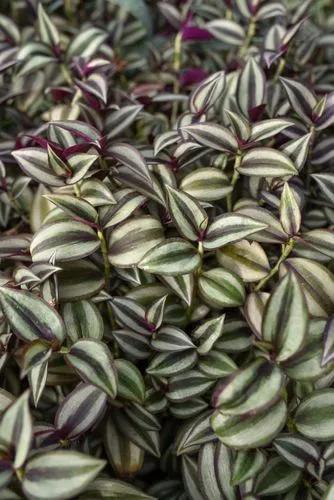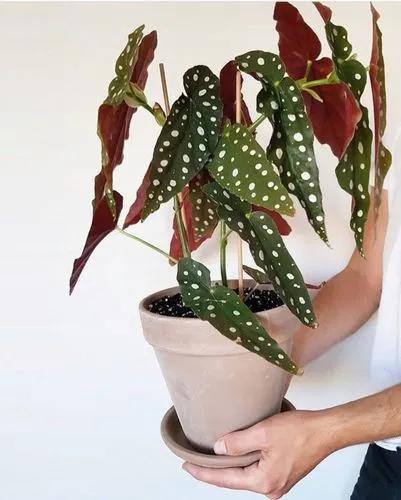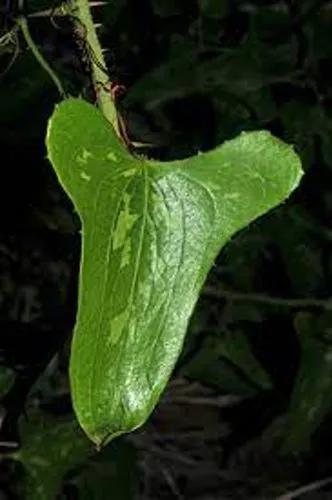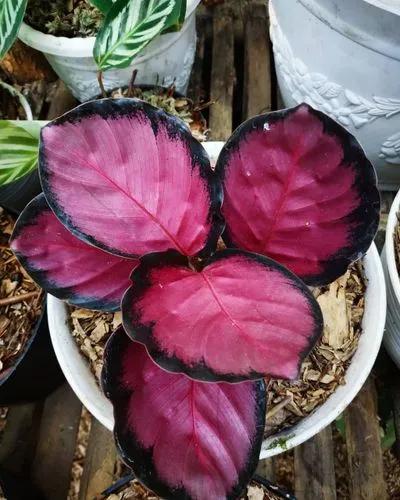Maranta leuconeura, also known as prayer plant, is a species of flowering plant in the family Marantaceae, native to the Brazilian tropical forests. It is a variable, rhizomatous perennial, growing to 30 cm (12 in) tall and broad, with crowded clumps of evergreen, strikingly-marked oval leaves, each up to 12 cm (5 in) long. The specific epithet leuconeura means "white-veined", referring to the leaves. The leaves have a habit of lying flat during the day, and folding in an erect position at night as if in prayer for evening vespers, hence the common name "prayer plant". This behaviour is an example of a diurnal rhythm. Small, white flowers appear during the growing season, although this is rarely observed in houseplants and the flowers are not of particular value in comparison to the attractive foliage. The broad leaves of the plant are oval, two-color, greenish and fairly shiny. There are spots on both sides of the leaf medium, the color of which varies depending on the variety. The spots may be light green, green, brownish or dark gray. Medium color also varies by variety. The undersides of the leaves are variable, ranging from a light green, common in M. leuconeura var. kerchoveana, to a deep red, common in M. leuconeura var. erythroneura. Roots are shallow.
Marante Kerchoveana Variegata Care
Marante Kerchoveana Variegata



How to Care for the Plant

Water

Water / Humidity: Soil should be kept moist, but not soggy. Water with tepid, room temperature water and either place near a humidifier or mist frequently (2 - 3x per week). Light: Ideally bright indirect light, and very tolerant of lower light (will just grow more slowly).

Pruning

Prune your prayer plant by cutting just above leaf nodes using a pair of sterilized garden scissors. Pruning two or three times a year (best times are in fall and spring) helps to encourage bushy growth. Pruning a prayer plant also helps to remove any leggy stems or dead leaves.

Fertilizer

You can apply a few drops of general houseplant fertilizer to the soil once a month from spring to summer, following the package instructions for dilution and administration. Do not provide nutrients in the fall and winter. Temperature: The range of 18 - 27°C is ideal. Will tolerate temperatures as low as 15°C.

Sunlight

Will tolerate low light.

Soil

Just stick it in the soil and leave it in the pot.

Temperature

Temperature: Average to warm temperatures from 18-27°C but can cope with as low as 15°C.

Additional

Despite being in the same family with Calathea's, she won't require as much humidity and will tolerate low light. Added bonus: Maranta Beauty Kim is not poisonous which means it's pet friendly (non toxic to cats and dogs). Despite being in the same family with Calathea's, she won't require as much humidity and will tolerate low light. Added bonus: Maranta Beauty Kim is not poisonous which means it's pet friendly (non toxic to cats and dogs).

Popularity

132 people already have this plant 23 people have added this plant to their wishlists
Discover more plants with the list below
Popular articles






